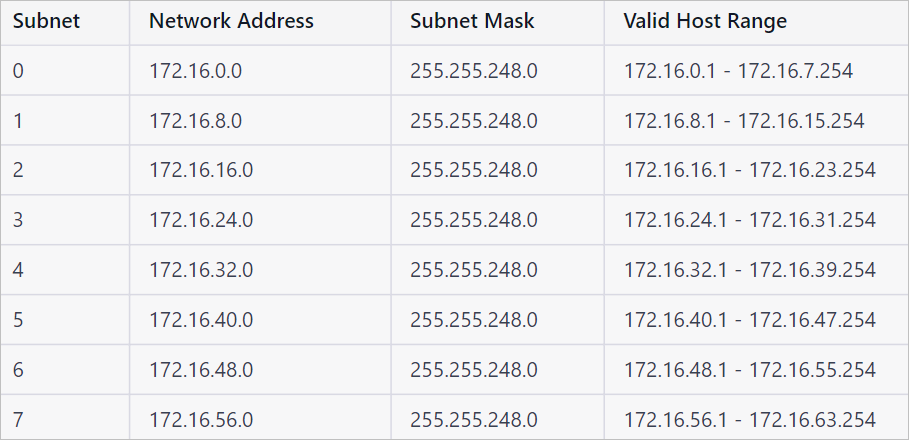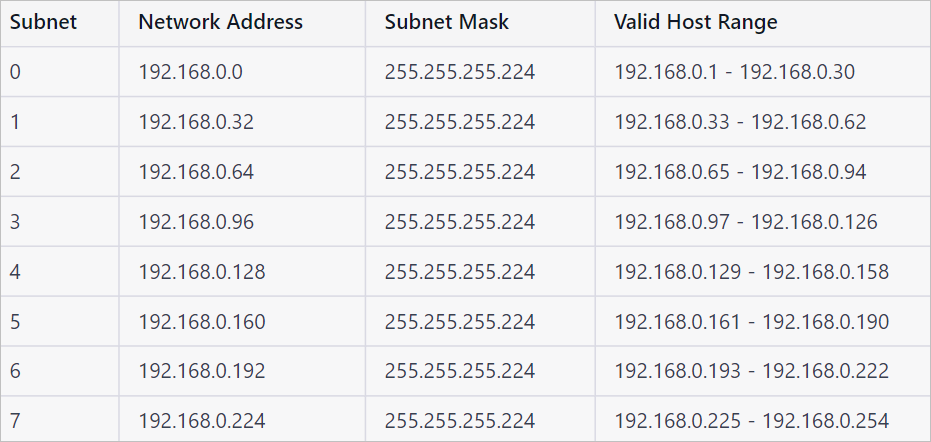Subnetting is the process of dividing a larger network into smaller sub-networks, known as subnets. Subnetting allows for better management of IP addresses and can improve network performance by reducing broadcast traffic. In this article, we will explore some subnetting examples to help you understand how subnetting works.
Example 1: Subnetting a Class A Network
Let’s say we want to subnet the Class A network 10.0.0.0/8 to create smaller subnets for different departments in our organization. We want to create 4 subnets with a maximum of 2,000 hosts per subnet.
To create 4 subnets, we need to borrow 2 bits from the host portion of the IP address. This leaves us with 14 bits for the host portion of the IP address, which gives us 16,384 IP addresses (2^14) per subnet.
To determine the subnet mask for each subnet, we need to determine the value of the bits we borrowed. In this case, we borrowed the first 2 bits, which gives us a value of 192 (11000000) in binary. Therefore, the subnet mask for each subnet will be 255.255.192.0.
The table below shows the network address, subnet mask, and valid host range for each subnet:
In this example, we created 4 subnets, each with a subnet mask of 255.255.192.0. This means that each subnet has 16,384 IP addresses available for hosts.
Example 2: Subnetting a Class B Network
As previously mentioned, we have been assigned the IP address 172.16.0.0/16, which means we have 65,536 IP addresses (2^16) available for our network. However, we want to divide this network into smaller subnets.
To subnet this network, we need to borrow bits from the host portion of the IP address. Let’s say we decide to borrow 4 bits to create 16 subnets (2^4). This leaves us with 12 bits for the host portion of the IP address, which gives us 4,096 IP addresses (2^12) per subnet.
To determine the subnet mask for each subnet, we need to determine the value of the bits we borrowed. In this case, we borrowed the first 4 bits, which gives us a value of 240 (11110000) in binary. Therefore, the subnet mask for each subnet will be 255.255.240.0.
The table below shows the network address, subnet mask, and valid host range for each subnet:
In this example, we created 8 subnets, each with a subnet mask of 255.255.248.0. This means that each subnet has 8,192 IP addresses available for hosts.
Example 3: Subnetting a Class C Network
A Class C network has an IP address range of 192.0.0.0 to 223.255.255.0. Let’s say we have been assigned the IP address 192.168.0.0/24 and we want to subnet it. This means we have 256 IP addresses (2^8) available for our network. However, we want to divide this network into smaller subnets.
To subnet this network, we need to borrow bits from the host portion of the IP address. In this case, we will borrow 3 bits to create 8 subnets (2^3). This leaves us with 5 bits for the host portion of the IP address, which gives us 32 IP addresses (2^5) per subnet.
To determine the subnet mask for each subnet, we need to determine the value of the bits we borrowed. In this case, we borrowed the first 3 bits, which gives us a value of 224 (11100000) in binary. Therefore, the subnet mask for each subnet will be 255.255.255.224.
The table below shows the network address, subnet mask, and valid host range for each subnet:
Conclusion
Subnetting can seem daunting at first, but it is an important tool for managing IP addresses and optimizing network performance. By dividing a larger network into smaller subnets, we can reduce broadcast traffic and improve network security. The examples above demonstrate how subnetting works and how to determine the subnet mask and valid host range for each subnet.
If you’re new to subnetting, it’s important to take the time to understand the basics before diving into more complex examples.
For additional resources and information on subnetting;
Subnetting Practice: https://www.subnettingpractice.com/
IP Subnet Calculator: https://www.calculator.net/ip-subnet-calculator.html



